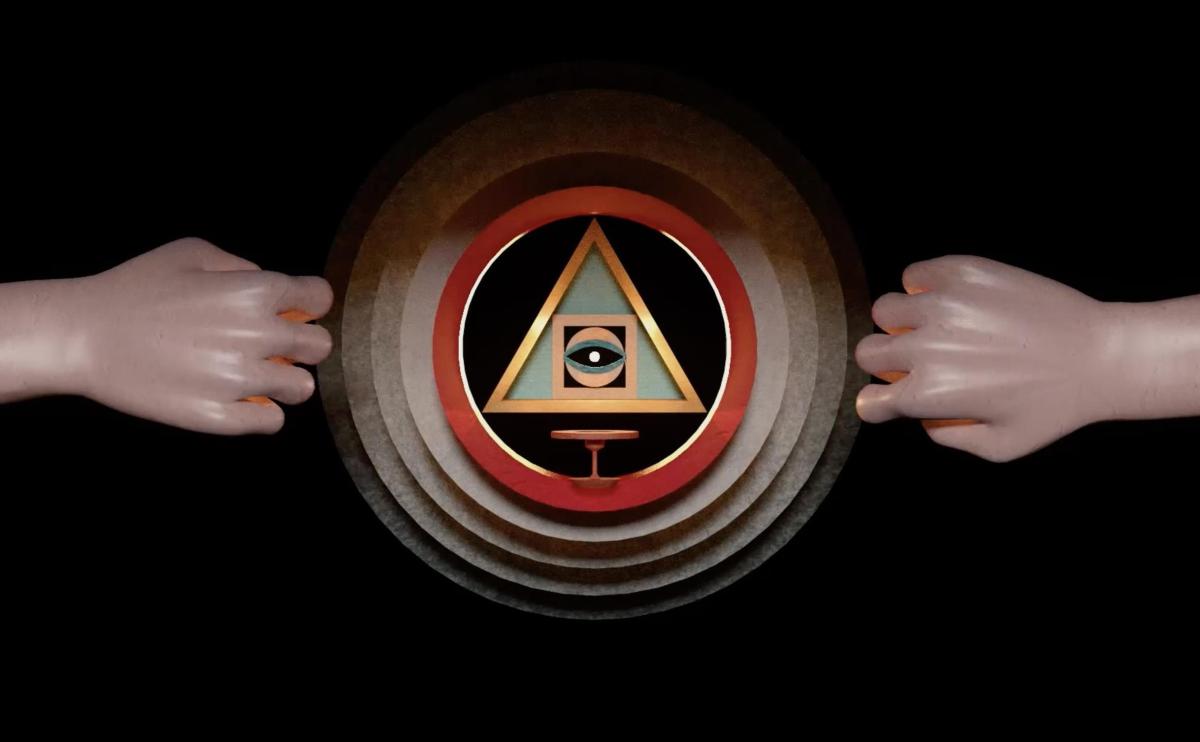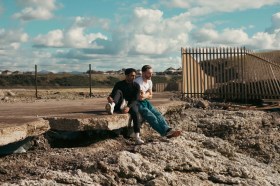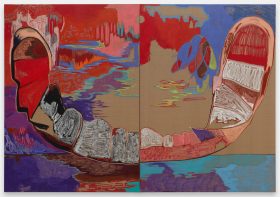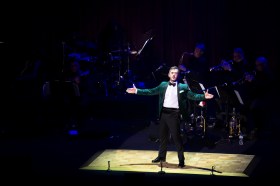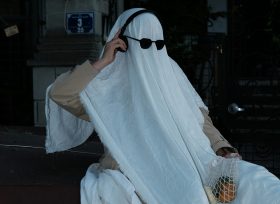While the media hype has focused on Beeple, Grimes and, more recently, Basquiat, there are artists closer to home who are also exploring NFTs. In March, Jess Johnson released five of the timepieces that appear in TERMINUS (2019), her major collaborative VR work with Simon Ward, as NFTs on Foundation. In April, she also began releasing characters from the video animation, Webwurld (2017), on a another NFT platform, Hic et Nunc. She called them ‘simple looping animations stuck in chimerical time tunnels. You can collect them all like trading cards’.
‘I do find it a bit weird getting asked to do interviews about NFTs,’ she said. ‘I’ve only recently sold a handful which doesn’t make me an expert by any means. Also this is not something I’m doing solo. I have a little group of friends (the Wurmfarm) who help workshop ideas and make things and I’m the biggest luddite of the bunch.’
Still, digital animation and NFTs have been a natural extension to a practice that also ranges across drawing, installations, ceramics and collaborations in music and fashion. TERMINUS is now up on the gaming platform Steam. ‘I don’t want to neg on the art world too much but it is rather an insular and rarefied space. It can be very exclusionary for a number of reasons so being able to reach wider audiences has always been more satisfying for me – people that don’t have access or inclination to visit art galleries but absorb art through popular culture in the same way I did when I was young, through posters, music, comics, book covers, gig fliers [and] video games.’
The audience for NFTs is, of course, an open question right now. ‘It’s kept us on our toes,’ Johnson said. ‘Our first release sold on Foundation with zero promo for 5 ETH which is about AU$16,000. That gave us a false sense of confidence – we thought that it was going to be raining money! But our next release didn’t attract any bids and it’s been fits and starts since then. That was probably a good thing to be honest. We sunk back down to earth and re-evaluated, and are now just trying to enjoy making things and finding our way.’
‘In these early days nothing makes sense and traditional art world conventions don’t have much mileage on these platforms,’ Johnson said. ‘I found my art world profile only counts for so much.’
Transition periods
The response ‘has been understandably mixed as people figure out how it all works and where they stand on the whole thing,’ said Johnson. ‘There’s been a lot of lash against artists getting involved in NFTs. It seems the traditional art world is very suspicious of NFTs and has shown a lot of contempt towards the scene, which has been a little funny to observe. I think the art world is inherently quite conservative and resistant to change, especially for things it doesn’t understand or can’t make money from.’
‘More legitimately there are environmental concerns about the huge energy consumption that some cryptocurrencies use. Luckily, there are alternative proof-of-stake currencies that are more energy efficient like Tezos or Cardano. (Ethereum is also transitioning to an energy-efficient model though it’s not there yet.) But a lot of people won’t bother to educate themselves beyond reading a headline like “NFTs are destroying the environment” then go on to righteously finger-wag at artists on social media. I’ve mainly tried to avoid all the arguing online and think we’re in a chaotic period of transition while everyone gets up to speed and finds their place.’

Jess Johnson in studio at the Pioneer Works Studio Residency in Brooklyn, New York. Image supplied.
Curator and academic Denise Thwates has been watching blockchain technologies closely. She said, ‘For a long time, people associated processes that were paperless or digital with being ecologically sustainable, but these debates around blockchain show that awareness around the damaging impacts of high energy consumption is increasing.’
She said the problem of ecological sustainability, not only for blockchain but also other energy intensive processes such as machine learning, should be addressed as urgent. ‘I hope the flurry of conversations around this topic can catalyse broader awareness and change around our dependence on computational power fuelled by fossil fuels. We need renewable and sustainable energy sources now.’
Challenging the traditional art world
Johnson is currently in New Zealand, but until recently was living and working in New York. TERMINUS is currently touring around Australia. This year, she also has a Te Whare Hēra Residency in Wellington, an exhibition at Mornington Peninsula Regional Gallery in Victoria, and is curating a ceramics exhibition for Te Uru Waitakere Contemporary Gallery in Auckland. This kind of activity is not very visible on NFT platforms – one reason why they have been hyped as anti-establishment, but also because of the way future trades are recorded, and artists guaranteed a cut.
‘The onsale royalties are a huge encouragement and incentive for artists and something that the traditional art world fails in,’ Johnson said. Foundation sets this at 10 percent. On Hic et Nunc, artists can set this amount themselves. ‘We choose 15 percent, which I think is fair to both buyer and artist. I just really like that there is a choice offered and it makes you think about the whole ecosystem instead of just your part in it.’
What happens nEXT?
Do NFTs really have the power to reshape the art world? ‘Ask me again in a decade,’ joked Thwaites. Like many, Thwaites is wary about the ‘NFT fever dream’ that has swept the art world since Christie’s Beeple sale, which to her mind reinforced rather than revolutionised the ‘existing art markets and power dynamics’.
The sudden attention has prompted fierce debate about NFTs but there are a lot of open doors right now. Thwaites pointed to artists like Rhea Myers who have been ‘experimenting with NFTs and blockchain DAOs since 2014’ and to recent local research into the potential impact of blockchain on Australia’s creative economy, which explored how it might ‘support artists in contracting, trading, managing resale royalties, and being discoverable to a broader online market of digital collectors through platforms like Opensea,’ she said.
‘At the same time, speculation and gimmicks in the art market are nothing new, so we should be cautious of statements that suggest that the Beeple price achieved at auction indicates a revolutionary shift for the art market.’
‘More optimistically, I hope the NFT buzz has rendered this field of digital practice more visible and stimulated more artists and digital producers to consider the economies they participate in.’
The people behind the tech
Last year Thwaites started Blocumenta with artist Baden Pailthorpe, hosting an event at Artspace in Sydney that drew together artists, curators, designers and software developers. ‘Blockchain networks are constituted through hardware, software and, of course, significant energy consumption that impacts our ecosystems. But I’ve also heard people in the blockchain scene compare this technology to Soylent Green – ultimately, it’s made of people,’ she said.
The event was about the ‘big and broad question’ of technology’s relationship to social and cultural change and, inevitably, this meant thinking about access and social equity. Blocumenta looked at things like organising community labour, collecting cultural artefacts and alternative economies. ‘We were hoping to position artists not just as responders to, and consumers of, technology but active participants in shaping their emergence,’ she said. ‘There’s a strong history of artists testing the limits and possibilities of new technologies and media as they emerge.’
One example is Ry David Bradley’s recent exhibition Once Twice, which saw him present his digital paintings as both digital tapestries for sale in a New York gallery and, at the same time, as NFTs for sale on SuperRare. Which one was authentic? Would collectors just want both? It was a project that cut to the deep issues around cultural value, authenticity and how art markets operate.
For Thwaites the most compelling projects in this space ‘really challenge us to think about what we value, and how we articulate value.’ This is not just about creating different digital assets, she added, but ‘seeing how communities can configure relationships of mutual care’.
Finding a place
There are many NFT platforms and different communities are emerging in different ways. The local artists using the invitation-only platform Foundation, for example, seem to skew towards motion designers and animators who’ve developed their skills in commercial settings.
‘From my experience, blockchain communities can be very eclectic, to the point where I find it hard to generalise about them,’ said Thwaites. ‘You find anarchist communitarians collaborating with hardcore libertarians, artists working with political economists, software developers and everything in between! That said, I consciously avoid the very loud tech-bro scene, which dominates a lot of the public discourse.’
For Johnson, the online communities around NFT platforms are not relevant to her practice. ‘To be honest I’m not a very online person,’ she said. But she has felt a difference between Foundation and Hic et Nunc, which she describes as ‘way more low key and experimental and artist friendly’.
‘It has very low mining [transaction] fees and trades in proof-of-stake Tezos which is like a million times more energy efficient than proof-of-work cryptocurrencies. The whole vibe is more like a zine fair; artists experimenting and selling affordable things to each other,’ she said.
‘Also the bigger platforms are massively saturated and you get lost in the sea of noise.’
What should artists weigh up?
‘Find a platform that suits you,’ Johnson said. ‘Don’t expect anything. Don’t spend too much money on mining fees. Try a lot of different stuff out. It’s a fun transitory time to be involved in NFTs before all the rules get entrenched in place. Everyone is just throwing a lot of stuff at the wall to see what sticks. Try to get your head around how cryptocurrencies work though be prepared to feel really dumb.’ She recommended listening to talks by Charles Hoskinson, a co-founder of the cryptocurrency Ethereum, to get an idea of the sci-fi potential of blockchains.
There are many pros and cons to consider. Thwaites also urged artists to spend some time learning the mechanics before launching in. ‘The majority of platforms you see in the NFT space interface with blockchains, providing a more accessible way to interact with these systems via a crypto-wallet. Something to bear in mind is that the private companies behind these platforms can go out of business,’ she said. ‘If you’re using Ethereum, there are tools such as Etherscan to help you find records of your transactions, so it’s a good idea to learn how to use them. Also, don’t forget your crypto-wallet password,’ Thwaites said. ‘If you lose these keys, you’re pretty stuffed.’